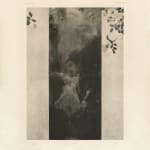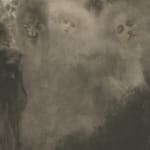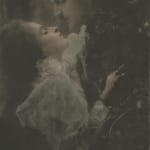Gustav Klimt Austrian, 1862-1918
1896
Further images
Klimt’s association with Martin Gerlach dates back to the early 1880s when Gerlach and Schenk published their first edition of Allegorien und Embleme. By the mid-1890s, they were planning updated and more modern editions. The publication was printed in an unknown number of copies. Klimt submitted this 1895 oil on canvas for inclusion as an allegory of love. In his rather thorny depiction, Klimt explores the darker side of romance. The formal elements create a sensuality and dreamlike mood in which the pressing of flesh and gauzy fabric amid musky flora and fauna is as palpable as the misty atmosphere. Conversely, Klimt’s central scene flanked on either side by panels lends a sense of theatricality or an otherworldly quality. Presented in this context, the spotlit face of the female lover, tightly and rather aggressively embraced by her male counterpart who appears engulfed by dark foliage, takes on a macabre effect. The spectral nature of the scene is reinforced by the ghostlike cast of characters looming above. Eight heads ranging from an apparition of a child, an image of the female lover’s face, to progressively more disturbing and decomposed female subjects culminate with a skeleton. Klimt considers the temporality of love and employs a familiar symbol to depict ephemerality, the rose, whose beauty and scent are fleeting. Klimt also links the rose’s symbolic image to the ghostly heads; there are eight heads and eight roses. Klimt gives equal billing to the rose’s leaves, stems and thorns whose color dominates the central scene and which nearly overwhelms in a jumble of brambly foliage. Personified by the male, love in the form of the rose bush which has ensnared the young woman in the prime of her beauty and her life, is capable of inflicting pain and hurt.
ALLEGORIEN-NEUE FOLGE, 1897, published by Gerlach & Schenk Verlag fur Kunst und Gewerbe, Vienna, was a serial publication that began as Allegorien und Embleme in 1882. A sourcebook of inspiration made for and by young Viennese artists became something of a galvanizer of the modernist movement in Vienna with its new series issued in 1897. Its publisher, Martin Gerlach, plucked young artists and even art students who were exploring the newest techniques in drafting and graphic design to contribute to his publication. This was the beginning of a long-standing relationship. In the forward to the 1897 edition, Gerlach, expounds upon the new approach which consciously shifted away from historicism rooted in the conservative Academy. Instead, the artists were encouraged to explore new subjects and new ways to present them. More unconventional subjects such as: Wine, Love, Song, Music and Dance; Arts and Sciences; the Seasons and their corresponding activities, sports and amusements, breathed fresh, modern life into the allegorical genre. Specific topics that were explored ranged from Electricity and new concepts of Work and Time to Bicycle Sport and the Graphic Arts.
Essentially, the publication served as a portable forum for sharing and disseminating new ideas. Two contributors, a young Gustav Klimt and an even younger Koloman Moser, likely met through their involvement with Allegorien and found themselves to be like-minded artists. As a result, the two allied with other artists and architects in a dramatic and formal break with the established, conservative state-run arts (Kunstlerhausgenessenschaft) to found the Vienna Secession the very next year in 1898. Klimt became the Secession’s first President; while Moser, in 1903, expanded the group from a solely exhibition-based focus to include a workshop by co-founding the Wiener Werkstatte. Gerlach went on to publish some issues of the Secession’s journal called Ver Sacrum as well as postcards designed by its members.
The Viennese art critic, Joseph August, called Gerlach the “Fuhrer der Moderne” (Leader of Modernism). The new 1897 series, featuring its innovative and modern art plates, is an important art historical document as it played a significant role in helping shape the avant-garde art movement in Vienna which exploded onto the scene with the formation of the Vienna Secession in 1898. Individually, the plates are important works; they are noteworthy for their stylistically and thematically modern approach. These plates offer some of the earliest examples of Viennese avant-garde and Secession artists’ published work.
Literature
See "Essential Klimt" by Laura Payne, 2001; pg 49.







